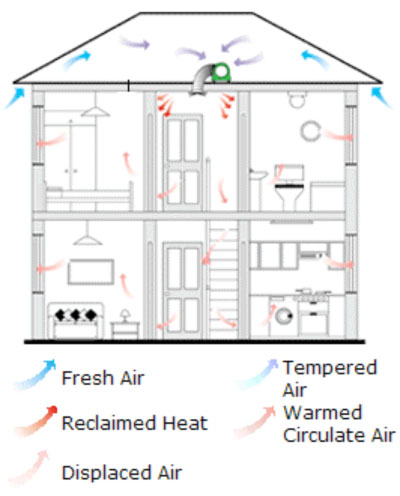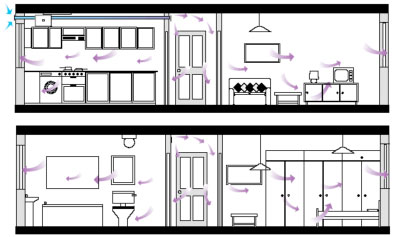- home
- testimonials
- diagnosing damp
- moving home?
- timber decay
- solid wall insulation
- dry rot
- pre-purchase report
- enquiry form
- case histories
- guarantee adoption
- fees for survey/ mortgage retention specials
- treatment options
- contact us
- environmental control
- condensation
- recession update
- damp & decay related articles
Condensation
WHAT IS CONDENSATION?
Condensation dampness in a building usually occurs when warm air comes
into contact with a cold surface. The air is cooled below its saturation
point causing its excess water vapour to change into liquid water. The
condensed water usually appears as water droplets or water film on
non-absorbent surfaces such as windows or tiles. This form of
condensation is described as surface condensation.
CONDITIONS FOR CONDENSATION DAMPNESS TO OCCUR
Condensation in houses is mainly a winter problem particularly where
warm moist air is generated in living areas and then penetrated to
colder parts of the building. Water vapour is produced in relatively
large quantities from a large number of activities. Condensation will
also occur under suspended timber floors where the temperature of humid
air in the floor space is lowered by cold air moving in through
ventilators and water is then condensed on the underside of the timber
floor, this will often induce timber decay of the wooden floor.
THE CAUSES OF CONDENSATION DAMPNESS
In houses condensation is related to modern living standards, economic
pressure and changing building design. The main cause of condensation is
naturally the generation of moist warm air by domestic activities. Moist
air can come from cooking, bathing, washing and drying clothes as well
as paraffin heaters and flueless gas heaters - up to 17 litres of water
can be produced daily in some homes (BRE Digest 297- Surface
Condensation & Mould Growth in Traditionally Built Dwellings). In
certain areas such as bathrooms and kitchens the moist, warm air can
spread to cooler parts of the house to condense on cold surfaces.
The effect of moisture generation is further aggravated by the way
houses are ventilated - it is theoretically possible to avoid
condensation by adequate ventilation. Up to about the late 1960s there
was natural ventilation in many homes because of the lack of
double-glazing, poorly fitting windows and doors, open fireplaces.
Present attitudes have eliminated natural ventilation by the use of
double-glazing, draught excluders, fitted carpets (preventing air
movement up through suspended wooden floor boards) and the removal of
open fireplaces with the introduction of central heating systems. To put
it simply buildings have being effectively sealed and provided ideal
conditions for condensation to occur.
Many houses remain unoccupied and unheated throughout the greater part
of the day allowing the fabric of the building to cool down, The
moisture producing activities are then concentrated into a relatively
short period. This sudden increase in warm air can produce condensation
as the air comes into contact with the relatively cold structure which
is still warming up. Rising gas and electric bills often force many
occupiers to under use heating systems, not heat unused rooms and seal
all draughts and reduce ventilation as described previously.
MOULD GROWTH
Mould growth will appear on any damp surfaces such as plaster,
wall-paper and timber and is associated with condensation problems in
many buildings. It is unacceptable because of appearance (unsightly
growths of various colours - greens, yellows, pinks, black, grey or
white).
The main requirement for the development and growth of moulds is a
source of moisture although food, oxygen and a suitable temperature are
also important. It is available water which is critical to mould
development. Moulds can be regarded as high hydrophilic fungi
(tolerating high water availability) although individual species have
their own optimum requirements for moisture. In most situations where
surface condensation occurs and the relative humidity of the internal
atmosphere exceed 70% mould growth will be established.
There have been approximately 100 species of fungi detected in dwelling
houses. The species most commonly encountered were penicillium,
cladosporium, rhizopus, and mucor.
CONCLUSION
Condensation dampness is an increasingly serious problem in dwelling
houses and offices. It affects over 50% of buildings in the UK.
Accompanying condensation dampness there is an increase in the presence
of mould growth and many of the household pollutants. Positive Input
Ventilation units (Dampbuster) along with our Passive Ventilation Units
(Mouldbuster) are a cost effective and guaranteed way to control
condensation and black spot mould problems.
Positive Input Ventilation units (Drimaster-for houses and Flatmaster
for flats)
Drimaster
The DRIMASTER provides whole home ventilation using the Positive Input
Ventilation principle. This form of ventilation is becoming increasingly
recognised as the "best value" approach to ventilating a home.
Essentially, the concept is to introduce air to the home at a continuous
low rate, encouraging movement of air from inside to outside. A single
unit situated in the loft space will normally be sufficient to
continuously dilute, displace and replace the old contaminated air in
the home with drier, tempered (by utilising otherwise unused heat in the
loft space) and filtered air. The result is a significant contribution
towards providing a healthy, condensation dampness free, energy
efficient home. With only one electrical connection and no trickle vents
normally required, the installation costs for this type of damp proofing
system are generally less than for a conventional set of extract fans
with trickle vents – and the entire home benefits from the ventilation
provided.
Good quality loft mounted units normally incorporate a heat recovery
function to introduce more heat into the home when the loft is warm
during the winter months. Heat recovery functions are normally either
"Fixed Temperature Heat Recovery" which adjust the flow rate of the unit
to suit the loft temperature; or "Intelligent Heat Recovery" which
adjusts the flow rate to suit the loft temperature and the way the home
is heated. The latter type is particularly good in terms of energy
efficiency. These systems are highly effective but do require proper
application and installation for optimum performance. Units
incorporating low watt motor technology (Low Energy Positive Input
Ventilation Units) can provide a significant net energy gain to the
home. These units are therefore very energy efficient, even when
compared to natural ventilation systems such as Passive Stack
Ventilation.

All DRIMASTER low energy input ventilation units are supplied and
fitted with a 60 day, no quibble, money back guarantee and also comes
with a 5 years parts & labour warranty. An average sized 3/4 bedroom
property, without extension, can be fully installed, including all
electrical connections for a flat fee of £750.00.
We also supply Drimaster units for self installation and prices are:
Drimaster Eco Heat- £450.00
All prices include V.A.T and delivery
The benefits of installing a Drimaster PIV unit are great and some of
the advantages are listed below:-
- First, it means that a significant proportion of external pollutants are prevented from entering the home.
- Secondly, the use of the otherwise unused heat in the roof results in the ventilation unit providing a significant net energy gain to the home.
- Thirdly, there is no better way to ventilate a home than from the inside out via a single, centrally located, supply air diffuser.
The installation of a low energy positive input ventilation unit will
ensure the air in your home is completely replaced with better quality
air around 20 times a day. This is the recommended rate to maintain good
air quality. The old air exits through the thousands of air leakage
points found in all homes. Indeed, positive input ventilation will even
help to suppress unwanted infiltration (draughts).
The end result of installing a DRIMASTER PIV unit is improved indoor air
quality and an environment in which condensation dampness cannot exist.
To arrange free no obligation feasibility survey then please call 0800
029 1903 or e-mail
enquiries@ukdamp.co.uk .
Flatmaster

The Flatmaster operates in a similar way to the Drimaster but is
designed for homes without lofts.
Input air is directed across the ceiling (usually in your hallway). This
uses a scientific principle called the Coanda effect, which has the
impact of mixing with the wasted warmer air that has risen above head
height in your home. It therefore increases the efficiency of your
heating system. We can also supply and fix heat exchange units if
preferred.
The unit will cure and/or prevent the problems associated with
condensation dampness in your home, providing a healthier living
environment for all occupants. The unit will prevent mould growth on
walls, ceilings, furniture, clothes and curtains. The unit also
eradicates the musty smells evident in homes with severe condensation
problems. (When using your air conditioning in the summer, fresh air
will circulate the house and help to prevent dry throats and
congestion).
The price for this unit supplied and fitted is £1,250.00 which includes
all making good and localised re-decorating.
For a free, no obligation feasibility survey please call 0800 028 1903
or e-mail enquiries@ukdamp.co.uk
Passive Ventilation Units
In some instances where cost is a concern and only individual rooms
require to be treated we can recommend the ‘Passyfier Vent’ which has no
running costs, has minimal heat loss and is scientifically proven to
reduce condensation dampness.
The Passyfier combines a through-the-wall ‘warm’ telescopic sleeve with
a slab of mineral wool inside, which is impervious to the exodus of
moisture vapour whilst an internal louvered vent and an external cover
simultaneously preventing cold draughts.
A typical house may need for or five Passyfier units and they operate by
taking advantage of the differential partial moisture vapour pressure
that is normally higher inside an occupied building than on the outside.
This pressure is completely independent of that in the air, for example,
a typically cold misty British winter’s day may have an outside
temperature of 5 oC and humidity at 100% while the inside temperature is
usually around 20oC. Keeping the inside relative humidity to 70%
generates a difference between inside and outside moisture vapour
pressure of 8 millibars which is ample to alleviate condensation. All
this is achieved with little or no heat loss and the Passyfier will
significantly reduce condensation dampness, steamy windows and
unsightly, unhealthy mould growth.
Building Regulations require background ventilation for habitable rooms
require a vent opening with a total area of not less than 8,000mm2 and
that these openings should be controllable, secure and located so to as
avoid draughts. Passyfier vents surpass all of these requirements and
are the ideal way of controlling high humidity levels, condensation
dampness of unsightly mould growth.
The Passyfier operates continuously without noise 24 hours per day and
can extract up to 2.3 litres (roughly one and a quarter gallons- which
is ten pints) of water per day even at low pressures.
The diffusion rate of a Passyfier vents are slower compared with
mechanical extract fans and they are not designed to cope with high
amounts of water vapour produced in a short time ( i.e. in kitchens and
bathrooms) and we recommend that if your kitchen or bathroom is
suffering from condensation dampness that extract fans are fitted.
If the Relative Humidity of a room is around 70%, above which
condensation dampness will occur at 20oC, each kg of air would hold
0.0104kg of water. Local Authorities recommend a maximum velocity of
0.9m/sec through vents, this is to avoid complaints about perceived
draughts from occupants, and this would remove 0.023m 3 of water vapour
per day. The average speed of air flow through a Passyfier vent is
around a tenth of the maximum speed allowable but it is still able to
remove 2.3 litres of water vapour per day and this greatly reduces the
possibility of condensation and unsightly mould growth from occurring.

The average price for supplying and fitting of a passive dehumidifier is £450.00 or we can supply units which are easily fitted by a competent builder for £75.00. If you need more information on the supply and installation of our passive dehumidifiers then please call 0800 028 1903 or e-mail enquiries@ukdamp.co.uk